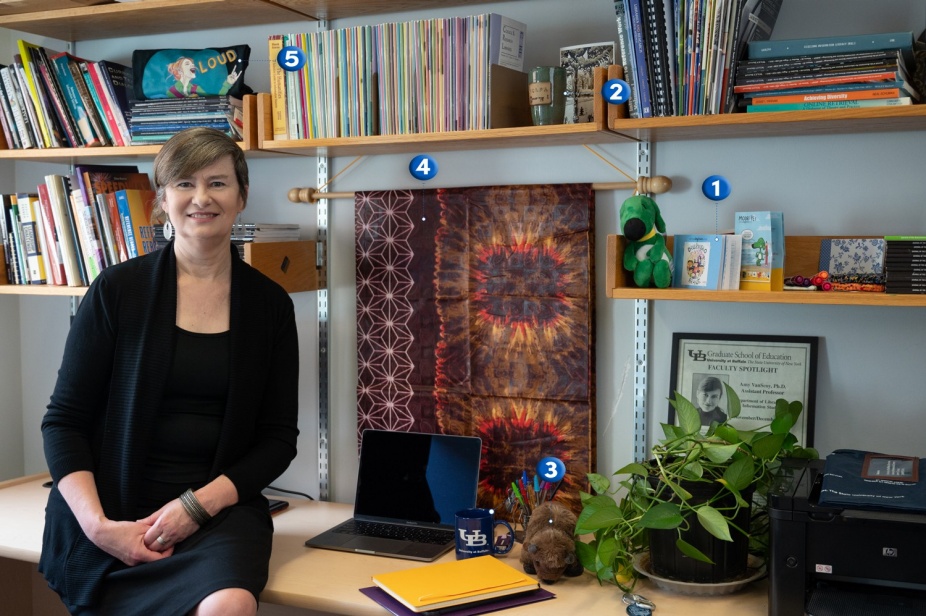Striving for more diversity in librarianship
Amy VanScoy is PI of a large grant to improve retention of underrepresented librarians
BY ANN WHITCHER GENTZKE
Studying the experience of BIPOC librarians as part of a grant from the American Library Association, Amy VanScoy made an unexpected discovery about her own cultural perspective.
VanScoy, associate professor of information science, and her frequent collaborator, Kawanna Bright, assistant professor at East Carolina University, were trying to find out what it is like for librarians of color who work in reference and information services. In the process, VanScoy learned about “the head nod,” a cultural idiom known to Bright as a Black woman, but which was lost on VanScoy, who is white. The nod, she learned, was an acknowledgement of shared experiences among Black librarians in a profession dominated by white women, and not to be misunderstood as a mere greeting.
“Neither [of us] had expected to encounter data so culturally entrenched that one of us would innately know what it meant and the other would be baffled,” the two wrote in a 2021 journal article.
VanScoy is now principal investigator on a $478,000 grant from the Institute of Museum and Library Services to improve retention of underrepresented librarians, who currently make up only 9.4% of the profession. “It’s a recruiting issue—we have to get more different types of people with different identities to be interested in librarianship,” she said. “We also have to keep them once they’re there.” Isolation, discrimination and low morale are among issues that put BIPOC librarians at risk for leaving the profession, the grant proposal stated.
- Diversity
- Global Issues
- Information Behavior
- Information Practices
- Information Science
- Library Science
- Qualitative Research Methods
The project will explore strategies for retention in a large quantitative study using “survival analysis,” a methodology frequently employed by Sunha Kim, associate professor in both the Department of Learning and Instruction and the Department of Counseling, School and Educational Psychology, and a member of the grant’s research team. The team, also including Bright of East Carolina University, will analyze and update a dataset collected in the 2000s when many librarians were retiring, and researchers were trying to gauge their job satisfaction and what was needed to bring in new people. The original study offered only male and female as choices for self-identification. This time, the analysis will include gender identity, VanScoy noted.
An academic librarian before earning her PhD at the University of North Carolina at Chapel Hill, VanScoy says she feels privileged to have worked in both practice and research. “In my research, I try to develop theories based on evidence from practice. And I try to be mindful of diversity, equity and inclusion, as well as global issues.”
VanScoy complements her scholarly career with interests that include travel and experiencing other cultures. She’s also a foodie and avid sci-fi fan in both books and movies. “It means escaping to some new world where it’s completely different,” she said.

While doing research in Slovenia, VanScoy was given this reading guide for families. There’s a place in the book for families to record their joint reading sessions, which are believed to encourage kids’ reading more than parental exhortations alone.

VanScoy kept this ceramic cup from the North Carolina Library Paraprofessionals Association for a presentation she gave. She held several positions with the North Carolina State University Libraries before embarking on an academic career.

“One of my colleagues who’s retired now gave me this stuffed bison. It’s meaningful to me and I always try to have my UB mug in view when on a Zoom call, because UB has been such a great place for me.”

A former visiting professor gave VanScoy this textile from South Africa that could be worn, but instead is displayed as a work of art in her office.

“My first semester here, the students had a big demonstration in UB Commons called ‘Librarians Loud’ to go against the stereotype of librarians as demure and quiet. I kept this T-shirt.”
